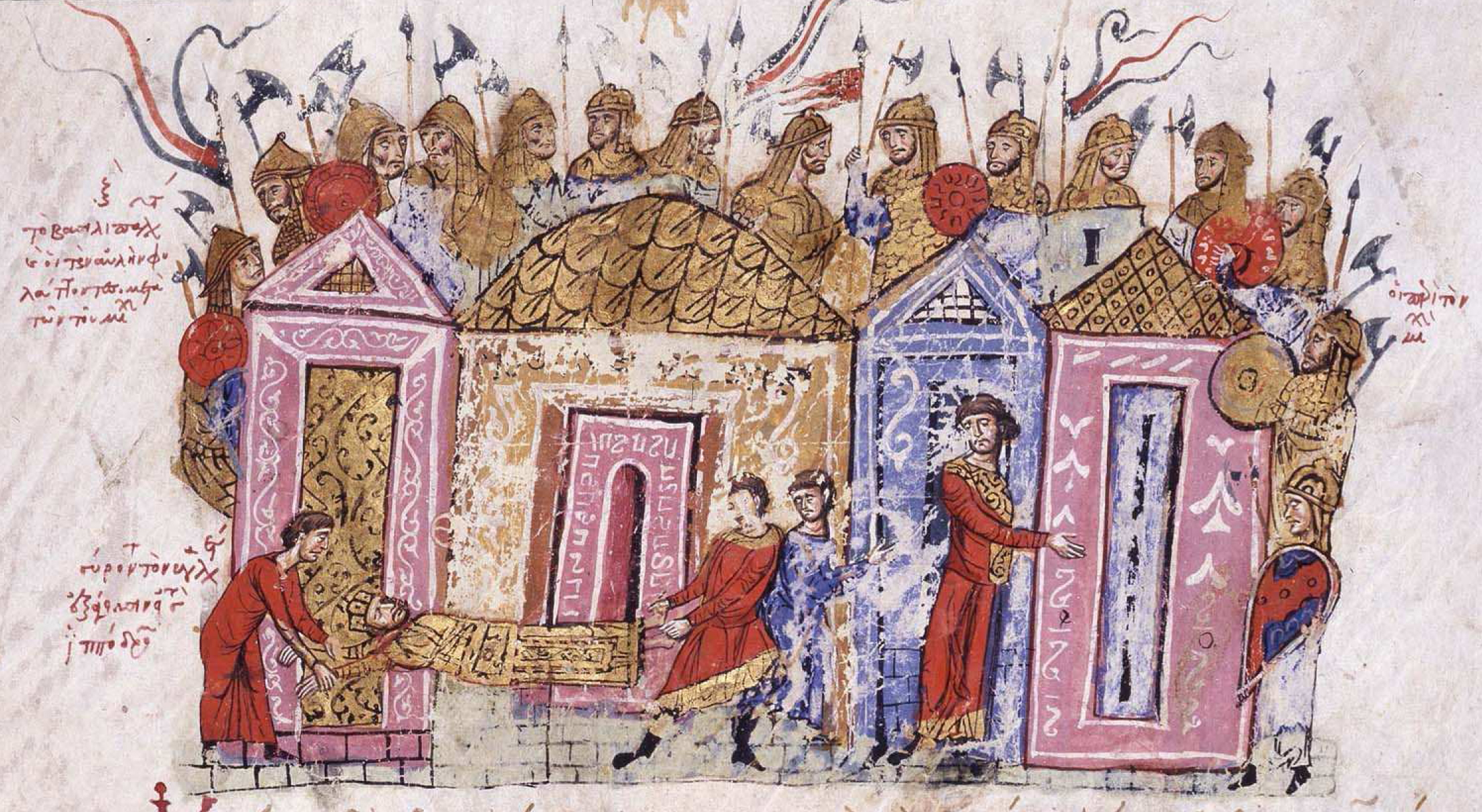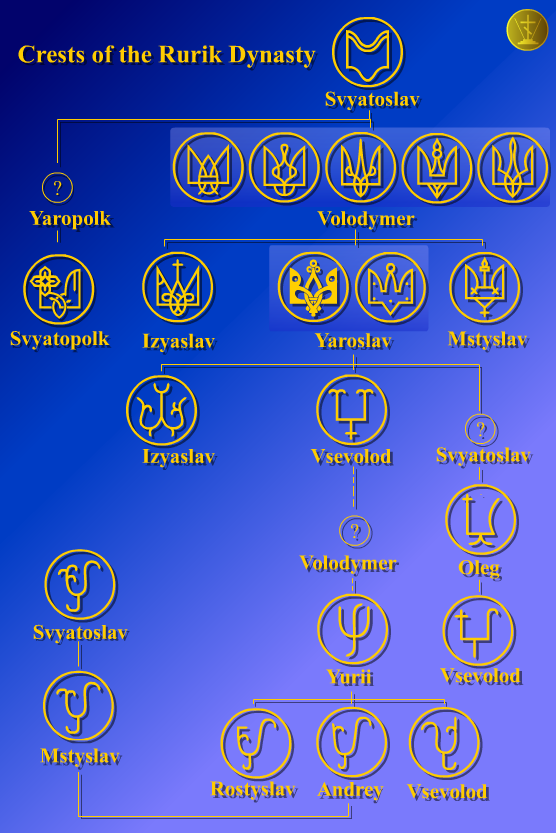|
Varangians
The Varangians ( ; ; ; , or )Varangian ," Online Etymology Dictionary were conquerors, traders and settlers, mostly from present-day Sweden, who settled in the territories of present-day Belarus, Russia and Ukraine from the 8th and 9th centuries and established the state of as well as the principalities of Polotsk and Turov. They also formed the |
Varangian Guard
The Varangian Guard () was an elite unit of the Byzantine army from the tenth to the fourteenth century who served as personal bodyguards to the Byzantine emperors. The Varangian Guard was known for being primarily composed of recruits from Northern Europe, including mainly Norsemen from Scandinavia but also Anglo-Saxons from England. The recruitment of distant foreigners from outside Byzantium to serve as the emperor's personal guard was pursued as a deliberate policy, as they lacked local political loyalties and could be counted upon to suppress revolts by disloyal Byzantine factions. The Rus' people, Rus' provided the earliest members of the Varangian Guard. They were in Byzantine service from as early as 874. The Guard was first formally constituted under Emperor Basil II in 988, following the Christianization of Kievan Rus' by Vladimir I of Kiev. Vladimir, who had recently taken control of Kiev with an army of Varangian warriors, sent 6,000 men to Basil as part of a military ... [...More Info...] [...Related Items...] OR: [Wikipedia] [Google] [Baidu] |
Kievan Rus'
Kievan Rus', also known as Kyivan Rus,. * was the first East Slavs, East Slavic state and later an amalgam of principalities in Eastern Europe from the late 9th to the mid-13th century.John Channon & Robert Hudson, ''Penguin Historical Atlas of Russia'' (Penguin, 1995), p.14–16. Encompassing a variety of polities and peoples, including East Slavs, East Slavic, Norsemen, Norse, and Finnic peoples, Finnic, it was ruled by the Rurik dynasty, founded by the Varangians, Varangian prince Rurik.Kievan Rus , Encyclopædia Britannica Online. The name was coined by Russian historians in the 19th century to describe the period when Kiev was preeminent. At its greatest extent in the mid-11th century, Kievan Rus' stretched from the White Sea in the north to the Black Sea in the south and from the River source, headwaters of the ... [...More Info...] [...Related Items...] OR: [Wikipedia] [Google] [Baidu] |
Rus' (people)
The Rus, also known as Russes, were a people in Early Middle Ages, early medieval Eastern Europe. The scholarly consensus holds that they were originally Norsemen, mainly originating from present-day Sweden, who settled and ruled along the Route from the Varangians to the Greeks, river-routes between the Baltic Sea, Baltic and the Black Seas from around the 8th to 11th centuries AD. The two original centres of the Rus' were Staraya Ladoga, Ladoga (''Aldeigja''), founded in the mid-8th century, and Rurikovo Gorodische (''Holmr''), founded in the mid-9th century. The two settlements were situated at opposite ends of the Volkhov (river), Volkhov River, between Lake Ilmen and Lake Ladoga, and the Norsemen likely called this territory ''Gardar''. From there, the name of the Rus' was transferred to the Middle Dnieper, and the Rus' then moved eastward to where the Finnic peoples, Finnic tribes lived and southward to where the Slavs lived. The name ''Garðaríki'' was applied to the ne ... [...More Info...] [...Related Items...] OR: [Wikipedia] [Google] [Baidu] |
Trade Route From The Varangians To The Greeks
The trade route from the Varangians to the Greeks was a medieval trade route that connected Scandinavia, Kievan Rus' and the Eastern Roman Empire. The route allowed merchants along its length to establish a direct prosperous trade with the Empire, and prompted some of them to settle in the territories of present-day Belarus, Russia and Ukraine. The majority of the route comprised a long-distance waterway, including the Baltic Sea, several rivers flowing into the Baltic Sea, and rivers of the Dnieper river system, with portages on the drainage divides. An alternative route was along the Dniester river with stops on the western shore of Black Sea. These more specific sub-routes are sometimes referred to as the Dnieper trade route and Dniester trade route, respectively. The route began in Scandinavian trading centers such as Birka, Hedeby, and Gotland, the eastern route crossed the Baltic Sea, entered the Gulf of Finland, and followed the Neva River into Lake Ladoga. Then it follow ... [...More Info...] [...Related Items...] OR: [Wikipedia] [Google] [Baidu] |
Primary Chronicle
The ''Primary Chronicle'', shortened from the common ''Russian Primary Chronicle'' (, commonly transcribed ''Povest' vremennykh let'' (PVL), ), is a Rus' chronicle, chronicle of Kievan Rus' from about 850 to 1110. It is believed to have been originally compiled in or near Kiev in the 1110s. Tradition ascribed its compilation to the monk Nestor the Chronicler, Nestor (''Nestor's Chronicle'') beginning in the 12th century, but this is no longer believed to have been the case. The title of the work, ("Tale of Bygone Years") comes from the opening sentence of the Laurentian Codex, ''Laurentian'' text: "These are the narratives of bygone years regarding the origin of the land of Rus', the first princes of Kiev, and from what source the land of Rus' had its beginning". The work is considered a fundamental source for the earliest history of the East Slavs. The content of the chronicle is known today from the several surviving versions and codices, revised over the years, slightly var ... [...More Info...] [...Related Items...] OR: [Wikipedia] [Google] [Baidu] |
Rurik
Rurik (also spelled Rorik, Riurik or Ryurik; ; ; died 879) was a Varangians, Varangian chieftain of the Rus' people, Rus' who, according to tradition, was invited to reign in Veliky Novgorod, Novgorod in the year 862. The ''Primary Chronicle'' states that Rurik was succeeded by his kinsman Oleg the Wise, Oleg who was regent for his infant son Igor of Kiev, Igor. Traditionally, Rurik has been considered the founder of the Rurik dynasty, which was the ruling dynasty of Kievan Rus' and its principalities, and ultimately the Tsardom of Russia, until the death of Feodor I of Russia, Feodor I in 1598. As a result, he is considered to be the traditional founder of the Russian monarchy. Life The earliest mention of Rurik is contained in the ''Primary Chronicle'', traditionally ascribed to Nestor the Chronicler, Nestor and compiled in , which states that East Slavs, East Slavic and Finnic peoples, Finnic tribes in 860–862 (including the Chuds, Novgorod Slavs, Slovenes, Krivichs ... [...More Info...] [...Related Items...] OR: [Wikipedia] [Google] [Baidu] |
Rurik Dynasty
The Rurik dynasty, also known as the Rurikid or Riurikid dynasty, as well as simply Rurikids or Riurikids, was a noble lineage allegedly founded by the Varangian prince Rurik, who, according to tradition, established himself at Novgorod in the year 862. The Rurikids were the ruling dynasty of Kievan Rus' and its principalities following its disintegration. The ''Romanovichi'' ruled the southwestern territories, which were unified by Roman the Great and his son Daniel, who was in 1253 crowned by Pope Innocent IV as the king of Ruthenia. Galicia–Volhynia was eventually annexed by Poland and Lithuania. The northern and northeastern territories were unified by the ''Daniilovichi'' of Moscow; by the 15th century, Ivan III threw off the control of the Golden Horde and assumed the title of sovereign of all Russia. Ivan IV was crowned as the tsar of all Russia, where the Rurik line ruled until 1598, following which they were eventually succeeded by the House of Romanov. As a ... [...More Info...] [...Related Items...] OR: [Wikipedia] [Google] [Baidu] |
Volga Trade Route
In the Middle Ages, the Volga trade route connected Northern Europe and Northwestern Russia with the Caspian Sea and the Sasanian Empire, via the Volga River. The Rus' (people), Rus used this route to trade with Muslim history#The Umayyad Caliphate, Muslim countries on the southern shores of the Caspian Sea, sometimes penetrating as far as Baghdad. The powerful Volga Bulgaria, Volga Bulgars (cousins of today's Balkans, Balkan Bulgarians) formed a seminomadic confederation and traded through the Volga river with Vikings, Viking people of Rus' and Scandinavia (Swedes, Danes, Norwegians) and with the southern Byzantine Empire (Eastern Roman Empire) Furthermore, Volga Bulgaria, with its two cities Bulgar and Suvar east of what is today Moscow, traded with Russians and the fur-selling Ugrians. Chess was introduced to Medieval Rus via the Caspian-Volga trade routes from Persia and Arabia. There was a second route from the Baltic Sea to the Dnieper, which ran along the Western Dvina (Dau ... [...More Info...] [...Related Items...] OR: [Wikipedia] [Google] [Baidu] |
Rus' Khaganate
Rus' Khaganate (, ''Russkiy kaganat'', , ''Ruśkyj kahanat''), or Kaganate of Rus is a name applied by some modern historians to a hypothetical polity suggested to have existed during a poorly documented period in the history of Eastern Europe between 830 and the 890s. The fact that a few sparse contemporaneous sources appear to refer to the leader or leaders of Rus' people at this time with the word ''chacanus'', which might be derived from the title of ''khagan'' as used by groupings of Asian nomads, has led some scholars to suggest that his political organisation can be called a "k(h)aganate". Other scholars have disputed this, as it would have been unlikely for an organisation of Germanic immigrants from the north to adopt such a foreign title. Some historians have criticised the concept of a Rus' Khaganate, calling it a "historiographical phantom", and said that the society of 9th-century Rusʹ cannot be characterised as a state. Still other scholars identify these early ... [...More Info...] [...Related Items...] OR: [Wikipedia] [Google] [Baidu] |
Vikings
Vikings were seafaring people originally from Scandinavia (present-day Denmark, Norway, and Sweden), who from the late 8th to the late 11th centuries raided, pirated, traded, and settled throughout parts of Europe.Roesdahl, pp. 9–22. They also voyaged as far as the Mediterranean Sea, Mediterranean, North Africa, the Middle East, Greenland, and Vinland (present-day Newfoundland in Canada, North America). In their countries of origin, and some of the countries they raided and settled in, this period is popularly known as the Viking Age, and the term "Viking" also commonly includes the inhabitants of the Scandinavian homelands as a whole. The Vikings had a profound impact on the Early Middle Ages, early medieval history of Northern Europe, northern and Eastern Europe, including the political and social development of England (and the English language) and parts of France, and established the embryo of Russia in Kievan Rus'. Expert sailors and navigators of their cha ... [...More Info...] [...Related Items...] OR: [Wikipedia] [Google] [Baidu] |
Byzantine Army
The Byzantine army was the primary military body of the Byzantine Empire, Byzantine armed forces, serving alongside the Byzantine navy. A direct continuation of the East Roman army, Eastern Roman army, shaping and developing itself on the legacy of the late Hellenistic armies, it maintained a similar level of discipline, strategic prowess and organization. It was among the most effective armies of western Eurasia for much of the Middle Ages. Over time the cavalry arm became more prominent in the Byzantine army as the Roman legion, legion system disappeared in the early 7th century. Later reforms reflected some Germanic peoples, Germanic and Asian people, Asian influences—rival forces frequently became sources of mercenary units, such as the Huns, Cumans, Alans and (following the Battle of Manzikert) Turkic peoples, Turks, meeting the Empire's demand for light cavalry Mercenary, mercenaries. Since much of the Byzantine military focused on the strategy and skill of generals utili ... [...More Info...] [...Related Items...] OR: [Wikipedia] [Google] [Baidu] |







